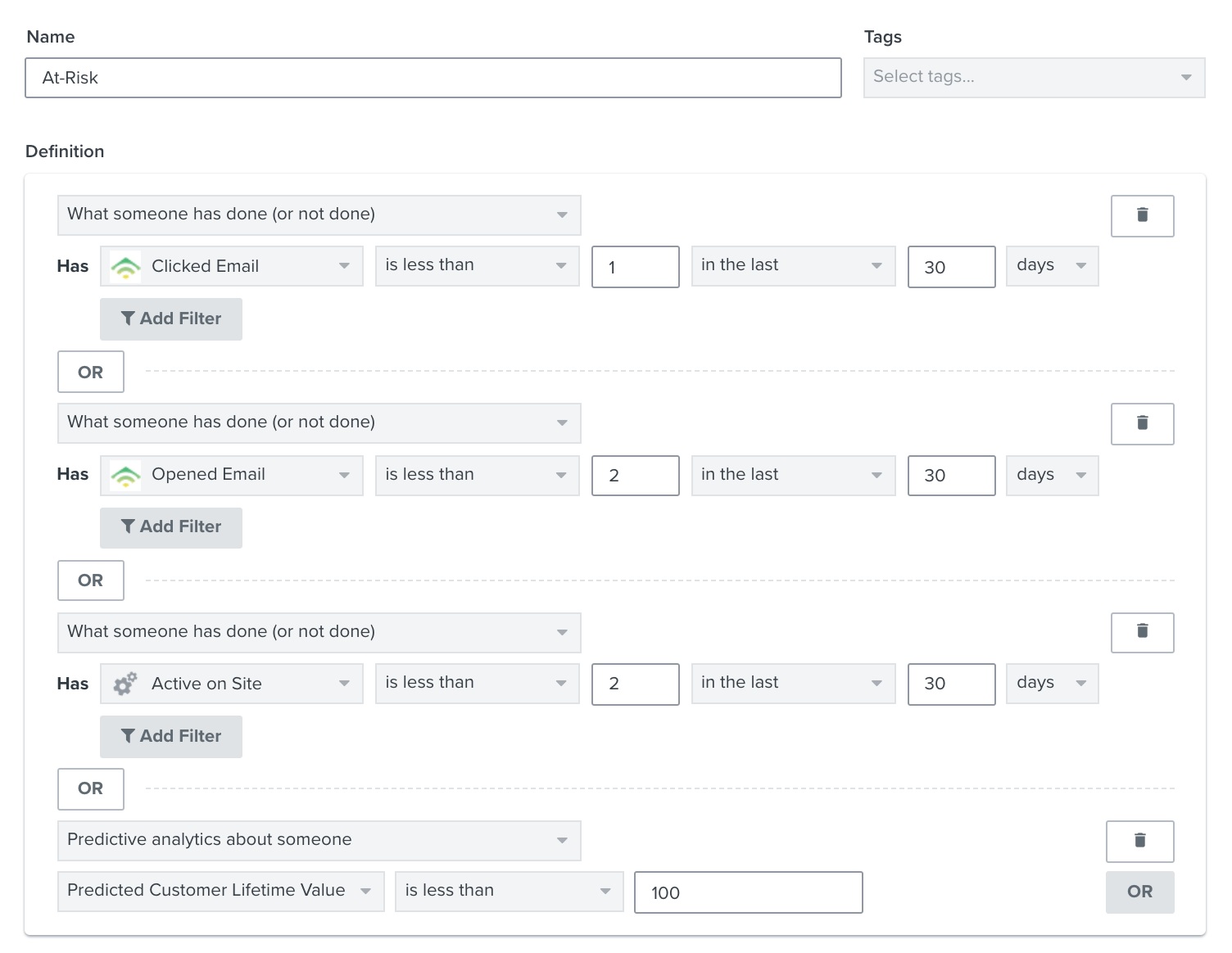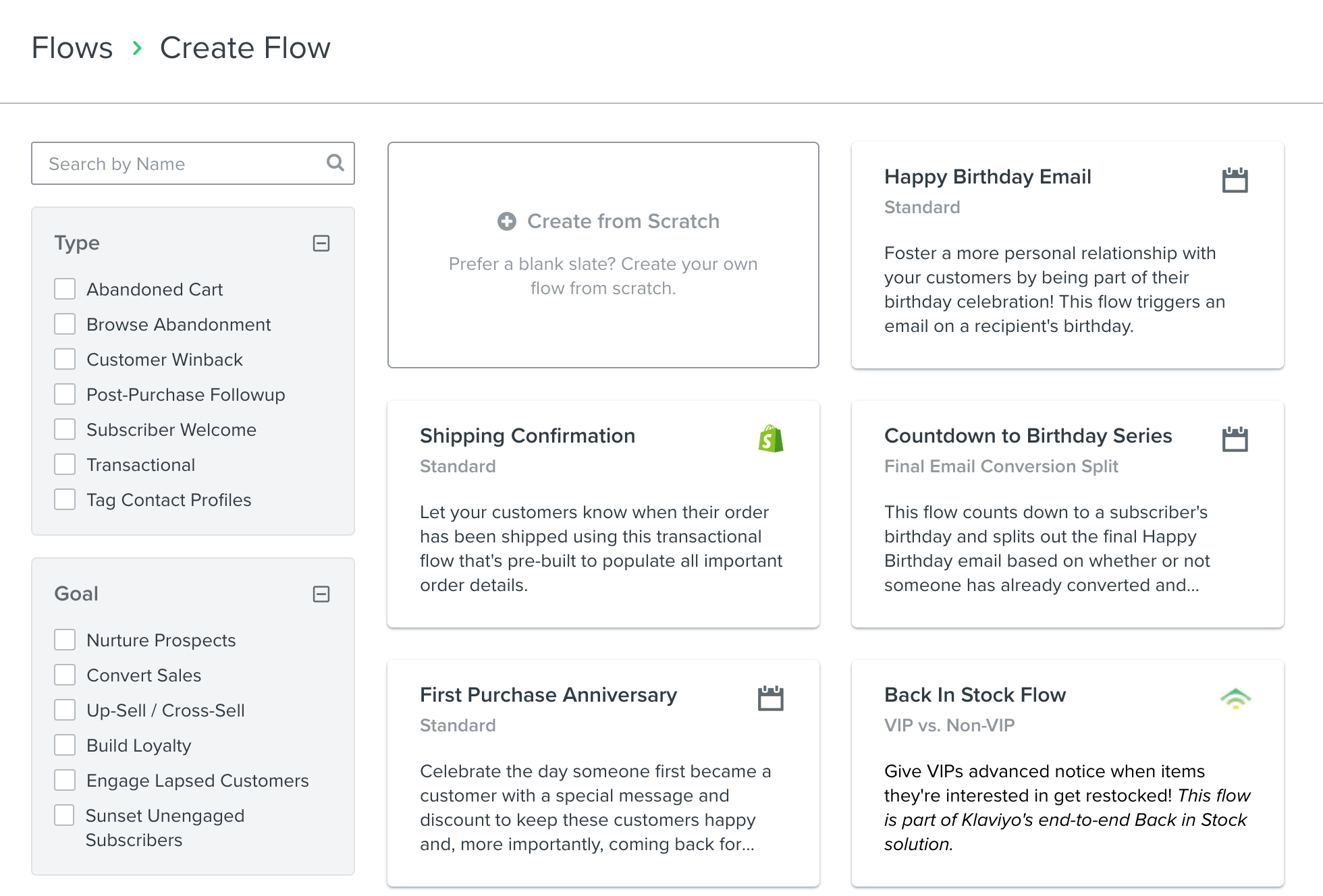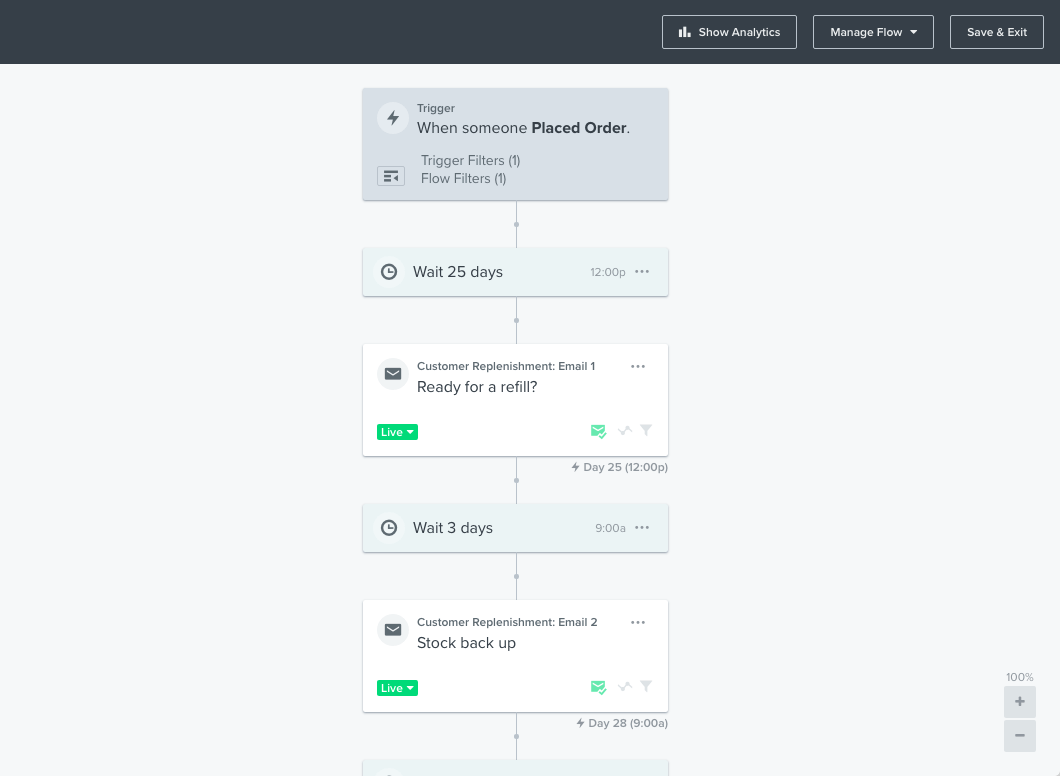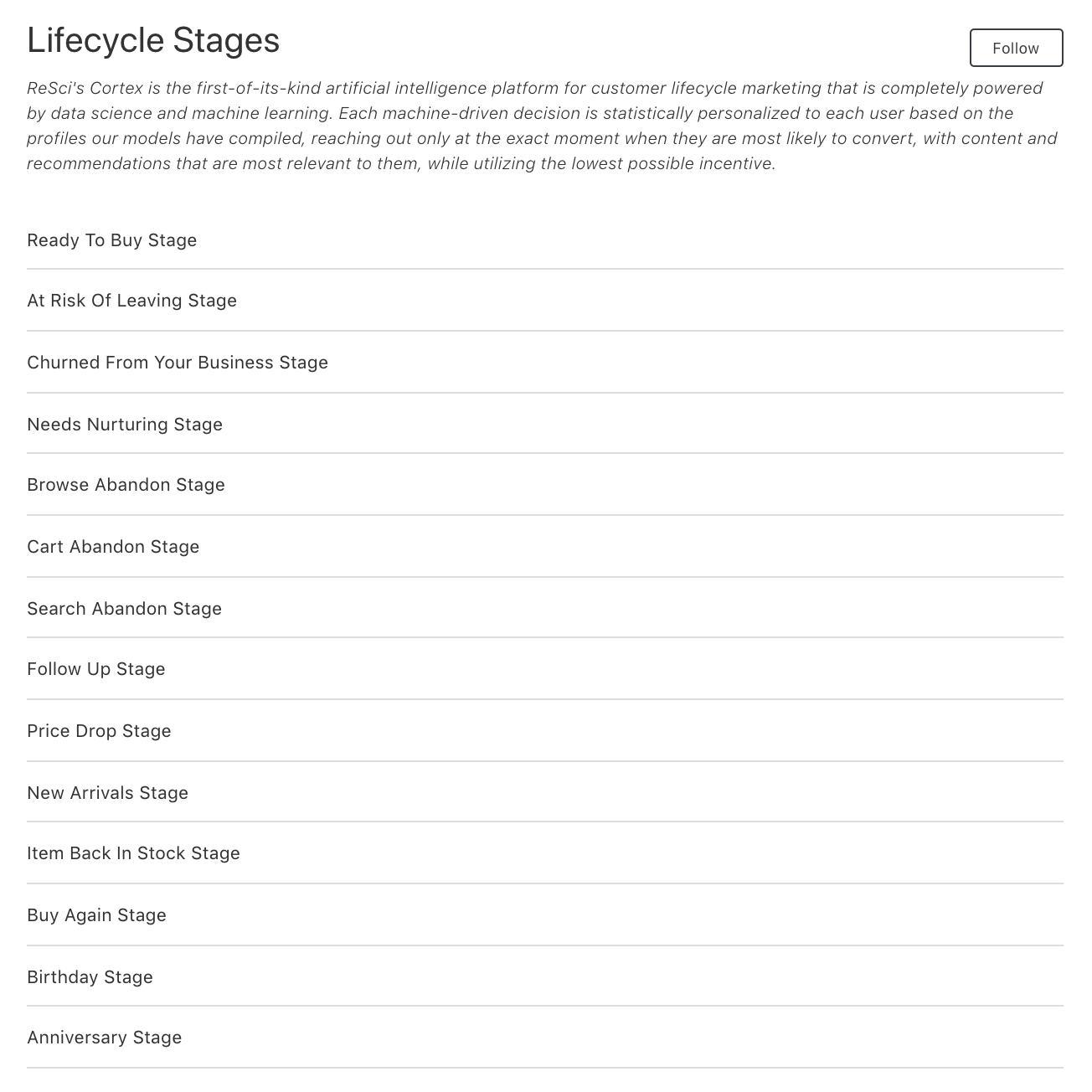Acquiring new customers is one half of the process of scaling your business. Retaining existing customers is the other. And reducing churn is essential to retaining more customers.
A quick recap: Churn rate is the rate at which you lose customers. To calculate churn rate, divide the total number of lost customers in a given time period by the total number of customers at the beginning of that same period.
Reducing your churn rate as you continue to grow means your product and messaging are resonating with your audience, and that you’re building meaningful relationships with your customers.
So how can an ecommerce business prevent churn? With email marketing.
The segmentation and automation capabilities of email service providers (ESPs) make them the ideal platforms to prevent churn by reaching customers with targeted messages at the right time.
But not all ESPs are created the same. Most ESPs have the ability to segment and automate, but the ease and options vary widely. Identifying churn within an email platform can be difficult, and creating an “at-risk” segment and subsequent automation might require a little finessing.
In our minds, here’s how two major ESPs, Klaviyo and Retention Science, stack up when it comes to helping brands prevent churn.
Segments to Prevent Churn
We first have to talk about the segments you need to build in order to identify those at risk of churning.
There are a few key actions (or lack thereof) that indicate a customer is likely to churn. The first being low engagement.
Low engagement typically signifies a user is at risk of churning.
Think about it: if a customer isn’t opening your emails, engaging with them, or browsing on your site, they probably aren’t looking to make another purchase anytime soon. We recommend creating a segment based on low website and email engagement.
The next is increased time between purchases. The longer a previous customer goes without purchasing, the less likely they are to come back.
These are both metrics you’d be able to see in your ESP through your ecommerce integration, like Shopify, and segment by. But many ESPs also enable merchants to create segments based on predictive analytics.
Predictive analytics attempt to anticipate when a person is going to display a certain behavior. They typically use past-purchase data and collective information about your customers to predict things like next purchase date, next purchase amount, and sometimes, risk of churning.
This is where Klaviyo and Retention Science differ in terms of preventing churn, as the models each platform uses to predict certain behaviors are unique to them.
Preventing Churn with Klaviyo and Retention Science
So back to our main question: how do Klaviyo and Retention Science stack up when preventing churn?
Klaviyo and Retention Science both have ways to set up segments and automations that will help your ecommerce business minimize churn. Klaviyo requires a more manual approach, whereas Retention Science takes on most of the heavy lifting.
We’ll explain:
Manually Build Segments and Automations with Klaviyo
Building segments and automations in Klaviyo takes some initial work up-front.
When you create a segment in Klaviyo, you have to manually set the conditions you want Klaviyo to filter by. You can create a segment with multiple conditions.
“And” conditions continue to filter down, meaning a customer has to fit both conditions in order to be included in the segment. “Or” conditions means a customer will be added to the segment if they meant at least one of the filters.
Because Klaviyo offers users a lot of control, building an at-risk segment means selecting the combination of properties you identify as signifying someone is at risk.
Like we mentioned, you’ll want to create an at-risk segment by combining low engagement behaviors and Klaviyo’s predictive analytics to identify customers at greater risk for churning.
Klaviyo’s predictive analytic segmentation options include segmenting by:
- Historic customer lifetime value: the total value of all a customer’s past orders.
- Predicted customer lifetime value: a customer’s predicted spend over the next year.
- Total customer lifetime value: the sum of a customer’s historic CLV and predicted CLV.
- Predicted number of orders: the predicted number of orders a customer will place over the next year.
- Average Days between orders: the average number of days between past orders for customers who have placed at least two orders. This average doesn’t include the time from the last purchase to the current day.
- Predicted Gender: a customer’s predicted gender as determined by their name.
For your at-risk segment, we recommend using predicted customer lifetime value, as a low predicted value means they’re not likely to make multiple purchases resulting in higher values.
Here’s what this segment would look like in Klaviyo’s segment builder:

The logic above means a user will be added to this segment if they click an email less than once in the last 30 days, if they open one or more emails less than two times in the last 30 days, if they are active on the site less than twice in the last 30 days, OR if they have a predicted lifetime value under $100.
Obviously, this information may change based on the price range of your products and how frequently you send emails.
Once you have a segment built, you can start an automation using that segment as a trigger.
Klaviyo has some common automation templates you can choose from. Or you can create one from scratch.

To prevent churn, you’ll want to set up a replenishment flow and a winback flow.
A replenishment flow is best used when your products have a set lifespan. That is, you know they’ll run out after a certain amount of time after buying.
By reviewing your existing purchase data, you can determine the established buying cycles of your customers and products, then set up a replenishment flow to target purchasers with a friendly and well-timed reminder.
Klaviyo walks customers through how to build and set up this replenishment flow here. You create a flow triggered by purchase behavior, since the replenishment timing will be specific to a certain product your customer purchased. Then, you’ll filter out anyone who makes a purchase during that flow, since the goal of making another purchase has been accomplished.

The first time delay will be based on the data you observed and the purchasing behavior of other repeat customers of that specific product.
Your replenishment flow serves to prevent churn before your customers have a chance to. Your winback flow is for those who are signifying that they are likely to churn.
You’ll want to set up a winback flow that is triggered when someone is added to your at-risk segment.
Similarly to your replenishment flow, Klaviyo has a “winback” template you can select, where you’ll set the trigger as being added to the at-risk segment, with a flow filter of making a purchase.
You can then customize the time delays and specific email content.
As we mentioned, Klaviyo is a very manual ESP. You have to specifically tell the platform who to segment and what emails to send them when.
Retention Science offers brands a more hands-off option, but makes it a little more difficult to draw out the trends in your data.
Let Retention Science Do the Work
Retention Science takes a more automated approach to segmenting and nurturing customers with automations.
While you can create segments to send what Retention Science calls “blasts” (one-time campaign emails), its segments and automations are pretty much hands-off, and come with the platform out-of-the-box.
Retention Science’s AI platform, called Cortex, automatically moves customers to different “stages” and sends them subsequent targeted emails.
You still have to create and design the emails Retention Science sends, and a customer won’t be moved to a different stage if emails aren’t enabled in that stage. But its stages are available from the get-go, and you don’t have to set up the logic to filter customers into a new segment or to move customers through an email funnel at a given stage.
Retention Science also has a unique Cortex set-up for subscription businesses.
These are all of the segments that are included with Retention Science’s Cortex:

Based on the segments and automations we recommended building in Klaviyo, in Retention Science you’d want to focus on creating multiple email designs for the “At Risk of Leaving,” “Churned from Your Business,” “Buy Again,” and “Needs Nurturing” stages to prevent churn.
Retention Science moves customers through these lifecycle stages in a specific order. First, customers are added to the “Buy Again” stage if the product they have previously purchased has a replenishment interval set.
Similar to Klaviyo’s replenishment reminder automation, this stage is meant to prevent churn before customers start displaying churning behaviors. It encourages a second purchase for a product that is used on a specific timeline within a period of time that makes sense.
Next, a customer is ushered into the “At Risk of Leaving” stage when their churn score falls out of what Retention Science calls the “Ready to Buy” phase. Churn score is a metric Retention Science calculates using its predictive analytics model to identify how at risk a customer is for churning.
This phase is one of the most critical for preventing churn, as a customer is beginning to signify they are likely to churn, but Retention Science doesn’t think they’ve actually churned yet.
After a customer completes Retention Science’s “At Risk” stage without making a purchase, they are moved to the “Churned” stage. Retention Science says, “when a client is classified by Cortex as “Churned” it means our data science models predict they will not purchase again, and this is predicted with 95-99.5% accuracy. “
The emails you create for the “Churn” phase are a last-ditch effort to encourage a purchase.
Finally, Retention Science will move inactive customers who have completed the “At Risk” and “Churned” stages into the “Needs Nurturing” stage. Needs Nurturing is a catchall for Retention Science, as subscribers who have completed the welcome fow, but have not made a purchase or indicated they will make a purchase, are also categorized as “Needs Nurturing.”
We recommend cleaning someone from your list if they complete the “Churned” stage without returning to make a purchase or displaying other engagement behaviors. “Needs Nurturing” emails, at that point, would only serve to annoy them and hurt your relationship with that customer. And designing and writing emails for inactive, churned customers AND newly subscribed, non-purchasers in the same automation would be difficult.
Not to mention, sending emails to unengaged subscribers will lower your sender score and increase the likelihood your marketing emails will be reported as spam over time.
Why We Prefer More Control
Retention Science is a great option for brands who need help getting set up or don’t have the capacity to mine the data for the insights they want.
But there’s an upside to the effort involved in building your own segments and automations in Klaviyo.
We like using Klaviyo because manually creating segments and automations allows us to become more familiar with the data and uncover qualitative insights.
For example, in order to create a segment based on predicted lifetime value, you have to decide what amount you consider a high potential value based on your range of products and how much customers typically spend.
It takes more work, but becoming intimate with the details of your data, segments, and analytics helps you apply these insights elsewhere.
Additionally, Retention Science’s stages send emails frequently throughout the predetermined lifespan of that stage. Without multiple email templates and designs set up, this means it’s possible for your email subscribers to get the same email multiple times while they’re actively in a given stage.
So while segments and automations are already set up in Retention Science, it would actually require more work to effectively make use of each stage by creating enough email designs to ensure a large enough variety so a customer never gets the same email.
Because Klaviyo flows work linearly, meaning you progress from email to email and never back again, you never run the risk of a customer getting the same email twice, unless you specifically set up a flow or design an email to do so.
So Which is Better?
Ultimately, that’s up to you and your brand’s needs.
Klaviyo is manual and requires a lot of thinking and planning upfront. Building out segments and flows means telling Klaviyo who you think is at risk for churning and exactly how you want to reach them. Conditional logic splits and testing within flows can get confusing fast.
But having to build at-risk segments and automations yourself means having a greater knowledge of who your at-risk customers are and what behaviors they exhibit, You can then take this knowledge and apply it elsewhere.
On the other hand, Retention Science makes it easy for those without a data background to segment and send nurturing emails without a lot of thinking. By semi-automating the process, your brand is always adhering to what Retention Science, as a popular ESP, determines to be best practices.
But you miss out on becoming familiar with your data and the behaviors of your customers. And the insights simply stop at how you can apply them to your email marketing.
Whichever platform you choose, you cannot overlook setting up automations that target those at risk of churning with persuasive and personalized messaging.
We partner with brands to improve the overall ecommerce experience for customers. Learn more about Barrel and the work we do for growing brands.
